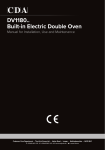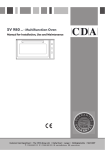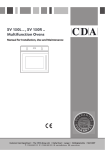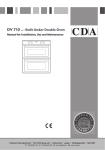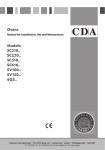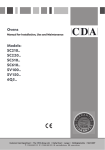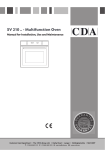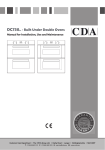Download CDA sk380 Specifications
Transcript
sk380.. Multifunction Oven Manual for Installation, Use and Maintenance Customer Care Department • The Group Ltd. • Harby Road • Langar • Nottinghamshire • NG13 9HY T : 01949 862 012 F : 01949 862 003 E : [email protected] W : www.cda.eu Important This appliance is designed and manufactured solely for the cooking of domestic (household) food and is not suitable for any non domestic application and therefore should not be used in a commercial environment. The appliance guarantee will be void if the appliance is used within a non domestic environment i.e. a semi commercial, commercial or communal environment. The CDA Group Ltd cannot be held responsible for injuries or losses caused by incorrect use or installation of this product. Please note that CDA reserve the right to invalidate the guarantee supplied with this product following incorrect installation or misuse of the appliance. Appliance Information: Please enter the details on the appliance rating plate below for reference, to assist CDA Customer Care in the event of a fault with your appliance and to register your appliance for guarantee purposes. Appliance Model Serial Number Declaration of CE Conformity This oven has been designed, constructed and marketed in compliance with: - Safety requirements of EU Directive “Low Voltage” 2006/95/EC; - Protection requirements of EU Directive “EMC” 2004/108/EC; - Requirements of EU Directive 93/68/EEC; - Requirements of EU Directive 2011/65/EU. Important Information for Correct Disposal of the Product in Accordance with EC Directive 2002/96/EC. At the end of its working life, the product must not be disposed of as urban waste. It must be taken to a special local authority differentiated waste collection centre or to a dealer providing this service. Disposing of a household appliance separately avoids possible negative consequences for the environment and health deriving from inappropriate disposal and enables the constituent materials to be recovered to obtain significant savings in energy and resources. As a reminder of the need to dispose of household appliances separately, the product is marked with a crossed-out wheeled dustbin. 2 IMPORTANT SAFETY PRECAUTIONS AND RECOMMENDATIONS IMPORTANT: This appliance is designed and manufactured solely for the cooking of domestic (household) food and is not suitable for any non domestic application and therefore should not be used in a commercial environment. The appliance guarantee will be void if the appliance is used within a non domestic environment i.e. a semi commercial, commercial or communal environment. Read the instructions carefully before installing and using the appliance. • After having unpacked the appliance, check to ensure that it is not damaged and that the oven door closes correctly. In case of doubt, do not use it and consult your supplier or a professionally qualified technician. • Packing elements (i.e. plastic bags, polystyrene foam, nails, packing straps, etc.) should not be left around within easy reach of children, as these may cause serious injuries. • Some appliances are supplied with a protective film on steel and aluminium parts. This film must be removed before using the appliance. • IMPORTANT: The use of suitable protective clothing/gloves is recommended when handling or cleaning this appliance. • Do not attempt to modify the technical characteristics of the appliance as this may become dangerous to use. The manufacturer declines all responsibility for any inconvenience resulting from the inobservance of this condition. • Do not operate your appliance by means of an external timer or separate remote-control system. • Do not carry out cleaning or maintenance operations on the appliance without having previously disconnected it from the electric power supply. • WARNING: Ensure that the appliance is switched off before replacing the oven lamp to avoid the possibility of electric shock. • Do not use a steam cleaner because the moisture can get into the appliance thus make it unsafe. 3 • Do not touch the appliance with wet or damp hands (or feet). • Do not use the appliance whilst in barefoot. • If you should decide not to use this appliance any longer (or decide to substitute another model), before disposing of it, it is recommended that it be made inoperative in an appropriate manner in accordance to health and environmental protection regulations, ensuring in particular that all potentially hazardous parts be made harmless, especially in relation to children who could play with unused appliances. • The various components of the appliance are recyclable. Dispose of them in accordance with the regulations in force in your country. If the appliance is to be scrapped, remove the power cord. • After use, ensure that the knobs/controls are in the off position. • Children less than 8 years of age shall be kept away unless continuously supervised. • This appliance can be used by children aged from 8 years and above and persons with reduced physical, sensory or mental capabilities or lack of experience and knowledge if they have been given supervision or instruction concerning use of the appliance in a safe way and understand the hazards involved. Children shall not play with the appliance. Cleaning and user maintenance shall not be made by children without supervision. • The manufacturer declines all liability for injury to persons or damage to property caused by incorrect or improper use of the appliance. • WARNING: During use the appliance and its accessible parts become hot; they remain hot for some time after use. –– Care should be taken to avoid touching heating elements inside the oven. –– The door is hot, use the handle. –– To avoid burns and scalds, young children should be kept away. • Make sure that electrical cables connecting other appliances in the proximity of the oven cannot become entrapped in the oven door. • WARNING: When correctly installed, your product meets all safety requirements laid down for this type of product category. However special care should be taken around the rear or the underneath of the appliance as these areas are not designed or intended to be touched and may contain sharp or rough edges, that may cause injury. 4 • FIRST USE OF THE OVEN - it is advised to follow these instructions: –– Furnish the interior of the oven as described in the chapter “CLEANING AND MAINTENANCE”. –– Switch on the empty oven on max to eliminate grease from the heating elements. –– Disconnect the appliance from the electrical power supply, let the oven cool down and clean the interior of the oven with a cloth soaked in water and neutral detergent; then dry carefully. • CAUTION: Do not use harsh abrasive cleaners or sharp metal scrapers to clean the oven door glass since they can scratch the surface, which may result in shattering of the glass. • Do not line the oven walls with aluminium foil. Do not place baking trays or the drip tray on the base of the oven chamber. • FIRE RISK! Do not store flammable material in the oven. • Always use oven gloves when removing the shelves and food trays from the oven whilst hot. • Do not hang towels, dishcloths or other items on the appliance or its handle – as this could be a fire hazard. • Clean the oven regularly and do not allow fat or oils to build up in the oven base or tray. Remove spillages as soon as they occur. • Do not stand on the open oven door. • Always stand back from the appliance when opening the oven door to allow steam and hot air to escape before removing the food. • SAFE FOOD HANDLING: Leave food in the oven for as short a time as possible before and after cooking. This is to avoid contamination by organisms which may cause food poisoning. Take particular care during warmer weather. • WARNING: Take care NOT to lift the appliance by the door handle. 5 Control Panel 3 4 2 5 1 Fig. 1 Controls Description 1. Oven thermostat knob 2. Oven switch knob 3. Clock and timer with “Touch-Control” keys Warning Lights: 4. Power on indicator lamp 5. Oven thermostat indicator light Please Note: This appliance incorporates a safety cooling fan which you will hear operating whenever the oven or grill are in use. This fan is to reduce the external temperature of the appliance and cool the internal components. 6 Multifunction Oven General Features As its name indicates, this is an oven that presents particular features from an operational point of view. In fact, it is possible to use 7 different programmes to satisfy every cooking need. The 7 positions, thermostatically controlled, are obtained by 4 heating elements which are: – Bottom element 1750 W – Top element 1200 W – Grill element 2850 W – Circular element 2500 W Note: Upon first use, it is advisable to operate the oven for 30 minutes in the position and to eliminate possible traces of grease on the heating elements. Repeat the operation for another 15 minutes with the grill element on as explained in the chapters TRADITIONAL GRILLING and USE OF THE GRILL. Operating Principles Heating and cooking in the MULTI-FUNCTION oven are obtained in the following ways: a. by Normal Convection The heat is produced by the upper and lower heating elements. b. by Forced Convection The fan at the back of the oven continuously draws the air over the circular heating element before sending in back through the oven, which allows complete and quick cooking. It is possible to cook several dishes simultaneously. c. by Semi-Forced Convection The heat produced by the upper and lower heating elements is distributed throughout the oven by the fan. d. by Radiation The heat is radiated by the infra red grill element. e. by Radiation and Ventilation The irradiated heat from the infra red grill element is distributed throughout the oven by the fan. f. by Ventilation The food is defrosted by using the fan only function without heat. 7 How to Use the Oven WARNING: The door is hot, use the handle. ATTENTION - MOST IMPORTANT Pay special attention not to touch the hot heating element inside the oven cavity. Thermostat Knob (Fig. 2) This only sets the cooking temperature and does not switch the oven on. Rotate clockwise until the required temperature is reached (from 50 °C to 250 °C). The thermostat indicator light will illuminate when the oven is switched on and turns off when the oven reaches the correct temperature. The light will cycle on and off during cooking in line with the oven temperature. Fig. 2 Function Selector Knob (Fig. 3) Rotate the knob clockwise to set the oven for one of the following functions: Oven Light By turning the function selector knob to this setting, the oven lights will illuminate in the oven cavity. The oven lights will operate on all selected functions. Traditional Convection Cooking Fig. 3 The upper and lower heating elements come on. The heat is dispersed by natural convection and the temperature must be set to between 50 °C and 250 °C with the thermostat knob. The oven must be preheated before cooking. Recommended for: Food that requires the same degree of cooking both inside and out, for example roasts, spare pork ribs, meringues etc. 8 Traditional Grilling The infrared grill element comes on. The heat is dispersed by radiation. Use with the oven door closed. The temperature can be regulated via the thermostat knob to between 50 °C and 225 °C. For cooking hints, see the chapter “USE OF THE GRILL”. Recommended for: Intense grilling, browning, cooking au gratin and toasting etc. It is recommended that you do not grill for longer than 30 minutes at any one time. Caution: the oven door becomes very hot during operation. Keep children well out of reach. Defrosting Frozen Foods Only the oven fan comes on. Use with the thermostat knob set to “ ” - other positions have no effect. The food is thawed by ventilation without heating. Recommended for: Quick thawing of frozen foods; one kg requires approximately 1 hour. Thawing times vary according to the quantity and type of food to be thawed. Hot Air Cooking The circular element and fan come on. The heat is dispersed by forced convection and the temperature can be regulated to between 50 °C and 250 °C via the thermostat knob. The oven does not require preheating. Recommended for: Food which has to be well-cooked outside and soft or rosy inside, for example lasagne, lamb, roast beef, whole fish etc. 9 Ventilated Grill Cooking The infrared grill element and the fan come on. The heat is dispersed mainly by radiation and the fan then distributes it all over the oven. Use with the oven door closed. The temperature can be regulated via the thermostat knob to between 50 °C and 225 °C. The oven must be preheated for approximately 5 minutes. For cooking hints, see the chapter “GRILLING AND AU GRATIN. Recommended for: Grilling where quick browning on the outside is required to keep the juices in. For example: veal steaks, chops, hamburgers etc. It is recommended that you do not grill for longer than 30 minutes at any one time. Caution: the oven door becomes very hot during operation. Keep children well out of reach. Maintaining Temperature After Cooking or Slowly Heating Foods The upper heating element, the circular element and the fan come on. The heat is dispersed by forced convection with greater intensity in the upper part. The temperature can be set to between 50 °C and 140 °C via the thermostat knob. Recommended for: Keeping food warm after any type of cooking. Slow heating of cooked food. Convection Cooking with Ventilation The upper and lower heating elements come on and the fan. The heat coming from above and below is dispersed by convection with ventilation. The temperature can be set to between 50 °C and 250 °C via the thermostat knob. Recommended for: Voluminous dishes and large quantities which require the same degree of cooking both inside and out, for example rolled roasts, turkey, roast legs, cakes etc. 10 Cooking Advice Sterilization Sterilization of foods to be conserved, in full and hermetically sealed jars, is done in the following way: a. Set the switch to position . b. Set the thermostat knob to position 185 °C and preheat the oven. c. Fill the grill pan with hot water. d. Set the jars onto the grill pan making sure they do not touch each other and the door and set the thermostat knob to position 135 °C. When sterilization has begun, that is, when the contents of the jars start to bubble, turn off the oven and let cool. Regeneration Set the switch to position and the thermostat knob to position 150 °C. Bread becomes fragrant again if wet with a few drops of water and put into the oven for about 10 minutes at the highest temperature. Simultaneous Cooking of Different Foods With the function selector in position and the ventilated oven allows you to cook different types of food at the same time. Fish, cakes and meat can be cooked together without the smells and flavours mixing. The only precautions required are the following: – The cooking temperatures must be as close as possible with a maximum difference of 20 - 25 °C between the different foods. – Different dishes must be placed in the oven at different times according to the cooking time required for each one. This type of cooking obviously provides a considerable saving on time and energy. Grilling and “Au Gratin” Grilling may be done by selecting grill+fan setting with the function selector knob, because the hot air completely envelops the food that is to be cooked. After having preheated the oven, simply place the food on the grid. Close the door and let the oven operate until grilling is done. Adding a few dabs of butter before the end of the cooking time gives the golden “Au Gratin” effect. Grill with the oven door closed. It is recommended that you do not grill for longer than 30 minutes at any one time. Caution: the oven door becomes very hot during operation. Keep children well out of reach. 11 Roasting To obtain classical roasting, it is necessary to remember: – that it is advisable to maintain a temperature between 180 °C and 200 °C. – that the cooking time depends on the quantity and the type of foods. Use of the Grill – Preheat the oven for about 5 minutes with the door closed. – Introduce the food to be cooked, positioning the rack as close to the grill as possible. – The grill pan should be placed under the rack to catch the cooking juices and fats. Grill with the oven door closed. It is recommended that you do not grill for longer than 30 minutes at any one time. Attention: the oven door becomes very hot during operation. Keep children away. The external parts of the oven become hot during operation. Keep children well out of reach. 12 Clock and Timer with “Touch-Control” Keys Keys and Touched simultaneously (for more than 2 seconds): – setting the clock; – setting the timer volume (by touching once, along with the “ ” key); – to cancel automatic cooking at any time. Function selection (touched for more than 2 seconds): – setting the clock (only after first connection or after a power failure); – timer; – automatic cooking “dur” (duration) - how long the food will take to cook (by touching the “ ” key again); – automatic cooking “End” - the time you would like the oven turns off (by touching the “ ” key two more times); Increases the number shown on the display Decreases the number shown on the display Fig. 4 Illuminated Symbols: AUTO flashing - Automatic cooking completed, oven in automatic position but not set AUTO steady illumination - Oven set for automatic cooking, cooking still not taking place “ ” flashing - Timer being set “ ” steady illumination - Timer in operation “ ” steady illumination - Oven set for manual cooking “ ” and AUTO AUTO flashing - Automatic cooking being set “ ” and AUTO steady illumination - Oven set for automatic cooking, cooking taking place. 13 “Touch-Control” Keys The “touch-control” keys should be operated by the fingers (just by touching the key). When using touch controls it is best to use the ball of your finger rather than the tip. The keys are automatically deactivated: – 8 seconds after the last selection; the deactivation is indicated by an acoustic signal (“beep”). To reactivate just touch the “ ” key or the “ ” and “ ” keys. Setting the Clock When first connected, or after a power failure, the digits and “AUTO” will show on the display. To set the clock, touch the “ ” key, for more than 2 seconds, and then the “ ” or “ ” keys. Important: The oven does not operate, in manual cooking, without first having set the clock. To set the clock, with the appliance already connected, touch the “ ” and “ ” keys simultaneously (for more than 2 seconds), then “ ” or “ ” keys. Important: - changing the time will delete any automatic program; – after setting the clock, the oven starts to operate in the selected function (manual cooking). The “ ” symbol is steady illuminated. Using the Timer You can use the timer at any time, even when the oven is not in use. The timer does not turn the oven off. The timer can be set for up to 23 hours and 59 minutes. – To set the timer, touch the “ ” key for more than 2 seconds (the “ ” symbol flashes), then the “ ” or “ ” keys. – After about 8 seconds an acoustic signal (“beep”) will sound confirming the regulation (“ ” symbol steady illuminated). – To check the remaining time touch the “ ” key for more than 2 seconds. If the remaining time is more than a minute the display will show hours and minutes; if less than a minute the display will show seconds. – When the time is up, the timer will beep. Touch the “ ” key , for more then 2 seconds, to turn it off; or press the “ ” or “ ” key to stop the beep and than the “ ” key, for more than 2 seconds, to deactivate the “ ” symbol flashing on the display. – Turn off the oven manually (function and thermostat knobs in the off position) if the manual cooking has been completed. Setting the Timer Volume You can select from three volume levels. – Touch the “ ” and “ – Touch the “ ” key; you can read on the display the current timer volume (“ton1”, “ton2” or “ton3”). ” keys simultaneously for more than 2 seconds. – Touch the “ ” key to listen or change the timer volume. – Timer volume activated: the last displayed. – After about 8 seconds an acoustic signal (“beep”) will sound confirming the volume setting; then the time of day will be displayed. 14 Automatic Cooking Use automatic cooking to automatically turn the oven on, cook, and then turn the oven off. 1. Check the clock shows the correct time. 2. Select the function and temperature (function and temperature knobs). The oven will come on. 3. Decide how long the food will take to cook, allowing time for preheating if necessary. 4. Touch the “ ” key for more than 2 seconds and then touch again. “dur” will show (duration). Using the “ ” and “ ” keys, set the cooking time. 5. Decide the time you would like the oven to turn off; touch the “ ” key for more than 2 seconds and then touch it two times again. “End” will show. Using the “ ” and “ ” keys, set the cooking time. Note: While “dur” is displayed you can change to “End” just by touching one time the “ from the last selection). ” key (within 8 seconds If there is time to wait before cooking starts, the current time of day and “AUTO” will show in the clock display. The oven will switch off but is now set for automatic cooking. If you are already at home to turn the oven on and only want the oven to turn off automatically, start cooking as normal, then follow step 4 or step 5 to set a time to stop the oven. When automatic cooking starts, “ ” will be displayed and the oven will turn on. – To see the remaining cook time, follow step 4 up to display “dur” (duration). – To see the set stop time, follow step 5 up to display “End”. – To cancel automatic cooking at any time, touch the “ ” and “ ” keys simultaneously (for more than 2 seconds) and turn the temperature and function knobs to the off position. When the stop time is reached, the oven will turn off, the timer will beep and “AUTO” will flash: – Touch any key to stop the beeping. – Touch the “ ” key, for more than 2 seconds, to return the oven to the manual mode (“ ” symbol steady illuminated on the display). – Turn the temperature and function knobs to the off position. Attention: After a power failure any automatic program is deleted. Turn off the oven manually. 15 Do’s and do not’s – Do always grill with the oven door closed. – Do read the user instructions carefully before using the oven for first time. – Do allow the oven to heat as indicated in the specific sections, before using for the first time, in order to expel any smell from the new oven insulation, without the introduction of food. – Do clean your oven regularly. – Do remove spills as soon as they occur. – Do always use oven gloves when removing food shelves and trays from the oven. – Do not allow children near the oven when in use. – Do not allow fat or oils to build up in the oven trays, or oven base. – Do not place cooking utensils or plates directly onto the oven base. – Do not grill food containing fat without using the grid. – Do not cover the grilling grid with aluminium-foil. – Do not use the oven tray for roasting. – Do not place hot enamel parts in water. Leave them to cool first. – Do not allow vinegar, coffee, milk, saltwater, lemon or tomato juice to remain in contact with enamel parts (inside the oven and on the oven tray). – Do not use abrasive cleaners or powders that will scratch the surfaces and the enamel. – Do not attempt to repair the internal workings of your oven. – Do remove the protective film before the first use. – Fire risk! Do not store flammable material in the oven. For Your Safety The product should only be used for its intended purpose which is for the cooking of domestic foodstuffs. Under no circumstances should any external covers be removed for servicing or maintenance except by suitably qualified personnel. Important Notes Installation, and any demonstration, information or adjustments are not included in the warranty. The oven must be installed by a suitably qualified and registered person in accordance with the relevant Standards. 16 ATTENTION: The appliance gets very hot, mainly around the cooking areas. It is very important that children are not left alone in the kitchen when you are cooking. Care and Maintenance It is advisable to clean when the appliance is cold and especially for cleaning the enamelled parts. Avoid leaving alkaline or acidic substances (lemon juice, vinegar, etc.) on the surfaces. Avoid using cleaning products with a chlorine or acidic base. WARNING When correctly installed, your product meets all safety requirements laid down for this type of product category. However special care should be taken around the rear or the underneath of the appliance as these areas are not designed or intended to be touched and may contain sharp or rough edges, that may cause injury. Inside of Oven The oven should always be cleaned after use when it has cooled down. The cavity should be cleaned using a mild detergent solution and warm water. Suitable proprietary chemical cleaners may be used after first consulting with the manufacturers recommendations and testing a small sample of the oven cavity. Abrasive cleaning agents or scouring pads/cloths should not be used on the cavity surface. NOTE: The manufacturers of this appliance will accept no responsibility for damage caused by chemical or abrasive cleaning. IMPORTANT: Before any operation of cleaning and maintenance disconnect the appliance from the electrical supply. ATTENTION: Let the oven cool down and pay special attention not to touch the hot heating elements inside the oven cavity. Enamelled Parts All the enamelled parts must be cleaned with a sponge and soapy water only or other non-abrasive products. Dry preferably with a micro fibre or soft cloth. 17 Stainless Steel, Aluminium, Painted Parts and Silk-screen Printed Surfaces Clean using an appropriate product. Always dry thoroughly. Stainless steel surfaces: can be cleaned with an appropriate stainless steel cleaner. IMPORTANT: these parts must be cleaned very carefully to avoid scratching and abrasion. You are advised to use a soft cloth and neutral soap. CAUTION: Do not use abrasive substances or nonneutral detergents as these will irreparably damage the surface. Glass Control Panel Clean using an appropriate product. Always dry thoroughly. Do not use harsh abrasive cleaners or sharp metal scrapers to clean the control panel since they can scratch the surface, which may result in shattering of the glass. CAUTION: Do not use a steam cleaner because the moisture can get into the appliance thus make it unsafe. CAUTION: Do not store flammable material in the oven. CAUTION: Do not use harsh abrasive cleaners or sharp metal scrapers to clean the oven door glass since they can scratch the surface, which may result in shattering of the glass. 18 Assembling and Dismantling of the Side Runner Frames – Assemble the wire racks to the oven walls using the 2 screws (Fig. 5). – Slide into the guides, the shelf and the tray (Fig. 6). The rack must be fitted so that the safety notch, which stops it sliding out, faces the inside of the oven; the guard rail shall be at the back. – To dismantle, operate in reverse order. Guard rail Fig. 5 Stop notch Fig. 6 19 Replacing the Halogen Oven Lights WARNING: Ensure the appliance is switched off before replacing the lamp to avoid the possibility of electric shock. - Allow the oven cavity and the heating elements to cool down; - Switch off the electrical supply; - Remove the protective cover C (fig. 7); - Replace the halogen lamp B with a new one suitable for high temperatures having the following specifications: 230V and same power (check watt power as stamped in the lamp itself) of the replaced lamp. IMPORTANT WARNING: Never replace the bulb with bare hands; contamination from your fingers can cause premature failure. Always use a clean cloth or gloves. - Refit the protective cover; Note: Oven bulb replacement is not covered by your guarantee. WRONG CORRECT C Fig. 7 20 B B C Oven Door Removing and Replacing the Inner Door Glass Pane for Cleaning If you wish to clean the inner glass of the door, make sure you follow the precautions and instructions very carefully. Replacing the glass pane and the door incorrectly may result in damage to the oven and may void your warranty. IMPORTANT! - Take care, the oven door is heavy. If you have any doubts, do not attempt to remove the door. - Make sure the oven and all its parts have cooled down. Do not attempt to handle the parts of a hot oven. - Take extreme care when handling the glass pane. Avoid the edges of the glass bumping against any surface. This may result in the glass shattering. - Do not use harsh abrasive cleaners or sharp metal scrapers to clean the oven door glass since they can scratch the surface, which may result in shattering of the glass. - If you notice any sign of damage on any of the glass panes (such as chipping, or cracks), do not use the oven. Call your Authorised Service Centre or Customer Care. - Make sure you replace the glass pane correctly. Do not use the oven without glass pane correctly in place. - If the glass pane feels difficult to remove or replace, do not force it. Call your Authorised Repairer or Customer Care for help. Note: service visits providing assistance with using or maintaining the oven are not covered by your warranty. 21 Removing the Oven Door The oven door can easily be removed as follows: - Open the door to the full extent (fig. 8a). - Open the lever A completely on the left and right hinges (fig. 8b). - Hold the door as shown in fig. 8. - Gently close the door (fig. 8c) until left and right hinge levers A are hooked to part B of the door (fig. 8b). - Withdraw the hinge hooks from their location following arrow C (fig. 8d). - Rest the door on a soft surface. Fig. 8a AA B B Fig. 8b Fig. 8c C C Fig. 8 22 Fig. 8d Removing the Inner Pane of Glass The oven door is fitted with no. 2 panes: - no. 1 outside; - no. 1 inner. To clean all panes on both sides it is necessary to remove the inner pane as follows: Remove the Inner Glass Retainer 1. Remove the oven door and place it on a soft surface. IMPORTANT: The door shall be placed horizontally as per Fig. 9. 2. Press down on both tabs to release the glass retainer. 3. Remove the glass retainer. 1 2 2 1 2 Fig. 9 23 Remove the Inner Glass Pane Lift and remove the inner pane slightly, as shown in the figure 10. 2 1 Fig. 10 24 After Cleaning, Replace the Inner Glass Pane When replacing the inner glass pane, make sure that: - you replace the pane correctly, as shown. The pane must be in the position described below in order to fit into the door and to ensure that the oven operates safely and correctly - you take extra care not to bump the edges of the glass against any object or surface - you do not force the pane into place. If you are experiencing difficulties replacing the pane, remove it and start the process again from the beginning. If this still does not help, call Customer Care - check that you are holding the pane the correct way. You should be able to read the wording on it as it faces you. 1. Insert the inner glass pane in the uppermost pair of grooves and push it slightly (arrow 1 in figure 11). 2. Gently lower into place (arrow 2 in figure 11). 2 1 Fig. 11 25 Replace the Glass Retainer 1. Position the glass retainer, as shown in the figure 12. It should sit on the bottom edge of the outer glass. Check that the clamps M are not deformed or damaged. 2. Gently push the glass retainer back into place. You should be able to hear the tabs on both sides click as they lock the glass retainer in. Important ! Make sure the glass retainer is correctly and firmly in place and that the glass pane is secure. 2 click M 1 M 1 M 2 click Fig. 12 26 Refit the Door 1. Hold the door firmly (fig. 13). 2. Insert the hinge tongues into the slots, making sure that the groove drops into place as shown in the figure 14. 3. Open the door to its full extent. 4. Fully close the levers A on the left and right hinges, as shown in the figure 15. 5. Close the door and check that it is properly in place. Fig. 13 A A Fig. 14 Fig. 15 27 ADVICE FOR THE INSTALLER Important Appliance installation and maintenance must only be carried out by QUALIFIED TECHNICIANS and in compliance with the local safety standards. • Failure to observe this rule will invalidate the warranty. • Always disconnect the appliance from the electrical supply before carrying out any maintenance operations or repairs. • The walls surrounding the oven must be made of heat-resistant material. • Taking care NOT to lift the oven by the door handle. The oven can be fitted in standard units, width 90 cm and depth 60 cm. Installation requires a compartment as illustrated in figures 16 and 17. On the lower side, the oven must lay on a surface that support the oven's weight. WARNING When correctly installed, your product meets all safety requirements laid down for this type of product category. However special care should be taken around the rear or the underneath of the appliance as these areas are not designed or intended to be touched and may contain sharp or rough edges, that may cause injury. 28 min. 860 480 467 478 853 n. mi 896 0 55 4 54 22 Fig. 16 min. 900 min. 860 480 467 478 853 n. mi 896 0 55 4 54 22 Fig. 17 29 Fixing the Oven Introduce the oven into the furniture opening and fix it with 4 screws (not supplied) as figure 18. It is essential that the oven rests on a surface which will support its weight, as the screw fixing is only complementary. Adjust the hinges of furniture doors adjacent to the oven to allow a 4-5 mm gap between the furniture door and the oven frame. Fig. 18 30 IMPORTANT: To avoid damage to the lower trim please note the following instructions. The lower trim is designed to allow for good air circulation and the correct opening of the oven door. To ensure the trim is not damaged due to the appliance being placed on the floor, the appliance should be suitably supported as in below illustrations. After installation the appliance door should be slowly opened to ensure no damage has occurred. No responsibility for lower trim damage will be accepted if these instructions have not been followed. OVEN DOOR Oven Door LOWER Lower TRIM Trim AIRFlow FLOW Air Fig. 19 31 Mains Electricity Connection Incorrect installation may be dangerous and the manufacturer can not be held responsible. Warning! This appliance must be earthed The manufacturer declines all responsibility for any problem caused by failure to observe this rule. THIS APPLIANCE MUST BE CONNECTED TO THE MAINS SUPPLY BY A COMPETENT PERSON, USING FIXED WIRING VIA A DOUBLE POLE SWITCHED FUSE SPUR OUTLET AND PROTECTED BY A SUITABLE FUSE. We recommend that the appliance is connected by a qualified electrician, who is a member of the N.I.C.E.I.C. and who will comply with the I.E.T. and local regulations. The wires in the mains lead of this appliance are coloured in accordance with the following code: Green & Yellow = Earth, Blue = Neutral, Brown = Live. As the colours of the wires in the mains lead for the appliance may not correspond with the coloured markings identifying the terminals connecting to the fuse spur, proceed as follows: DOUBLE POLE SWITCHED FUSE SPUR OUTLET • The wire which is coloured green and yellow must be connected to the terminal marked E (Earth) or coloured green. •The wire which is coloured blue must be connected to the terminal marked N (Neutral), or coloured black. FUSE ON • The wire which is coloured brown must be connected to the terminal marked L (Live), or coloured red. Note: Use a suitable FUSE in accordance with the appliance power rating Use a suitable FUSE in accordance with the appliance power rating Fig. 20 Assembly and electrical connection should be carried out by specialised personnel. When installing this product we recommend you seek the help of another individual. 32 Connection of the Power Supply Cable Unhook the terminal board cover by inserting a screwdriver into the two hooks A (fig. 21). Open the cable gland by unscrewing screw F (fig. 22), unscrew the terminal screws and remove the cable. The new supply cable, of suitable type and section, is connected to the terminal board following the diagram of fig. 23. F A Fig. 21 Feeder Cable Section Type H05RR-F 230 V~ Fig. 22 230 V E Earth NNeutral LLive 3 x 1.5 mm2 L N E Fig. 23 33 Appliance Servicing CDA provide a quality and effective after-sales service to cover all your servicing needs. Please attach your receipt to this page for safekeeping. Please help us to help you by having the following information available when booking a service-call: 1. Model type, make and model – see the product data plate. 2. Evidence of installation / purchase date 3. Retailer where appliance was purchased 4. Clear and concise details of the fault 5. Full address including postcode and any contact phone numbers Contact Telephone Numbers CDA Customer Care Department – Telephone: 01949 862012 – Fax: 01949 862003 – Email: [email protected] 34 35 Cod. 1104703 - ß2 Please contact our Customer Care Department, or for Service on the details below. Customer Care Department • The Group Ltd. • Harby Road • Langar • Nottinghamshire • NG13 9HY T : 01949 862 012 F : 01949 862 003 E : [email protected] W : www.cda.eu




































